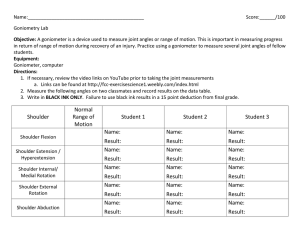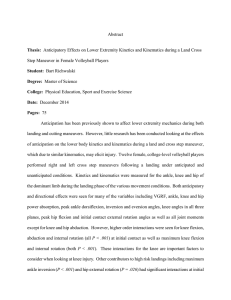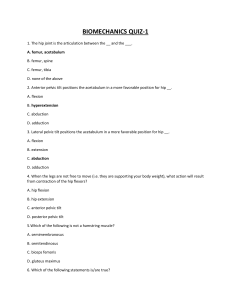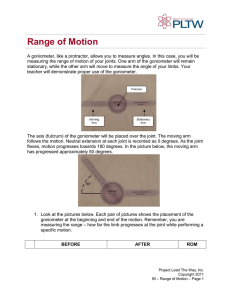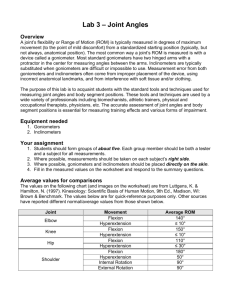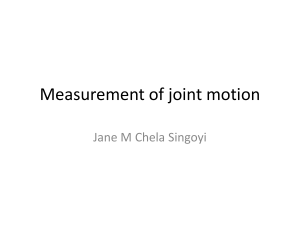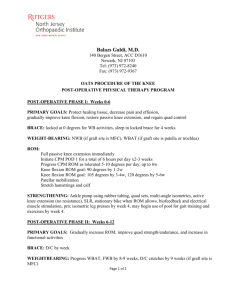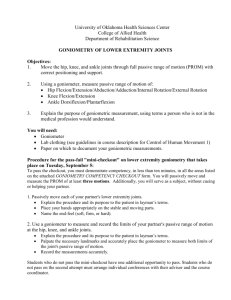Lab #5
advertisement
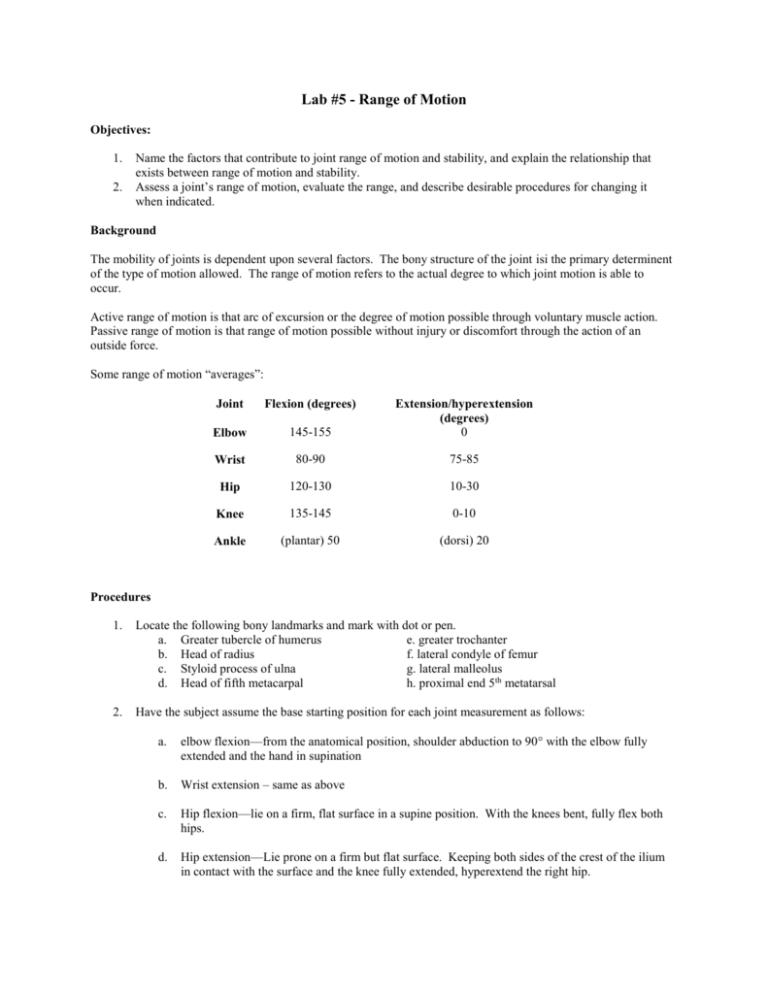
Lab #5 - Range of Motion Objectives: 1. 2. Name the factors that contribute to joint range of motion and stability, and explain the relationship that exists between range of motion and stability. Assess a joint’s range of motion, evaluate the range, and describe desirable procedures for changing it when indicated. Background The mobility of joints is dependent upon several factors. The bony structure of the joint isi the primary determinent of the type of motion allowed. The range of motion refers to the actual degree to which joint motion is able to occur. Active range of motion is that arc of excursion or the degree of motion possible through voluntary muscle action. Passive range of motion is that range of motion possible without injury or discomfort through the action of an outside force. Some range of motion “averages”: Joint Flexion (degrees) Elbow 145-155 Extension/hyperextension (degrees) 0 Wrist 80-90 75-85 Hip 120-130 10-30 Knee 135-145 0-10 Ankle (plantar) 50 (dorsi) 20 Procedures 1. Locate the following bony landmarks and mark with dot or pen. a. Greater tubercle of humerus e. greater trochanter b. Head of radius f. lateral condyle of femur c. Styloid process of ulna g. lateral malleolus d. Head of fifth metacarpal h. proximal end 5th metatarsal 2. Have the subject assume the base starting position for each joint measurement as follows: a. elbow flexion—from the anatomical position, shoulder abduction to 90 with the elbow fully extended and the hand in supination b. Wrist extension – same as above c. Hip flexion—lie on a firm, flat surface in a supine position. With the knees bent, fully flex both hips. d. Hip extension—Lie prone on a firm but flat surface. Keeping both sides of the crest of the ilium in contact with the surface and the knee fully extended, hyperextend the right hip. 3. e. Knee—Assume a prone position on a firm surface. Keeping the thigh in alignment with the pelvis and hip, and the pelvis in contact with the surface, flex the knee. Then move so that the leg if fully extended will move beyond the end of the surface (to allow for full extension), extend the knee. f. Ankle—In a sitting position with the knee at 90 (short sit), measure plantar and dorsiflexion. The goniometer axis shall be below the malleolus. Place the goniometer on the subject so that the fixed arm of the goniometer is along the mechanical axis of the proximal, or fixed, segment of the active joint. Place the moveable arm of the goniometer along the mechanical axis of the segment moved after the final range of motion position has been reached. Do not try to keep the goniometer on the moving segment during the motion. All measurements should be done on the same side of the body. 4. Record your results for maximum active and passive range of motion in both flexion and extension (hyperextension) of the lab report. Answer all discussion questions. 5. Graph your results on graph paper. On this graph compare your results to the ranges presented as average. For each joint, graph the ROM average value from page 1 and your active and passive ROM values from the table on the next page. Use a bar graph format. Each joint will have three bars. You should be able to fit all joints on the same graph. The vertical axis will be ROM in degrees, and the horizontal axis will be a list of the joints. Data – Range of Motion in Degrees Flexion ACTIVE Elbow Wrist Hip Knee Ankle Extension (hyperextension) PASSIVE ACTIVE PASSIVE Total Active ROM (in degrees) RANGE TOTAL DEGREES OF MOTION Elbow Wrist Hip Knee Ankle Questions: 1. Where did the subject’s active range of motion measurements fall outside of those presented as average? (Be specific as to joint name and amount of difference found.) JOINT FLEXION EXTENSION (HYPEREXTENSION) 2. Speculate on specific reasons in each joint that might account for any differences you found. 3. Compare the active range of motion to the passive range of motion. In general, which of the two was greater? How would you explain this difference? 4. What anatomical factors either enhanced or limited the range of motion in each joint?
